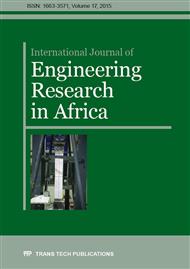[1]
Longo, D. and G. Muscato (2006), The Alicia 3 Climbing Robot, Robotics and Automation Magazine, vol. 13, no. 1, pp.2-10.
Google Scholar
[2]
Cui G., Guo H. Li and D. Gu (2012), Design of a Climbing Robot Based on Electrically Controllable Adhesion Technology, in International Conference on Solid State and Materials (ICSSM), pp.90-95.
Google Scholar
[3]
Journee, M., X. Chen and M. Sellier (2011), An Investigation into Improved Non-Contact Adhesion Mechanism Suitable for Wall Climbing Robotic Applications, International Conference on Robotics and Automation (ICRA), p.4915–4920.
DOI: 10.1109/icra.2011.5979842
Google Scholar
[4]
Daijun Xu, Ningjun Fan, Kejie Li and Koki Kikuchi (2006), Suction ability analysis of a novel wall climbing robot, in Proceedings IEEE Int. Conf. Robotics and Biomimetics, Kunming, China, pp.1506-1511.
DOI: 10.1109/robio.2006.340152
Google Scholar
[5]
Yang Li, Man-tian Li and Li-ning Sun (2007), Design and passable ability of transitions analysis of a six legged wall-climbing robot, in Proc. IEEE Int. Conf. Mechatronics and Automation, China, 5-8, pp.800-804.
DOI: 10.1109/icma.2007.4303647
Google Scholar
[6]
Masataka Suzuki, Shinya Kitai and Shigeo Hirose (2007), New types child units of anchor climber: Swarm type wall climbing robot system, IEEE/RSJ Int. Conf. Intelligent Robots & Systems, USA, pp.1781-1786.
DOI: 10.1109/iros.2007.4399141
Google Scholar
[7]
Fischer W, and R. Siegwart (2007).
Google Scholar
[8]
Kim H, Kim D, Yang H (2008), Development of a wall-climbing robot using a tracked wheel mechanism, Journal of Mechanical Science and Technology, (l22): 1490-1498.
DOI: 10.1007/s12206-008-0413-x
Google Scholar
[9]
Zhang, H. X., Wang, W., Zhang, J. (2009), Novel Passive Adhesion Principle and Application for an Inspired Climbing Caterpillar Robot, IEEE Int. Conf. on Mechatronics (ICM 2009), Vol. 1 & Issue 2, pp.637-642.
DOI: 10.1109/icmech.2009.4957150
Google Scholar
[10]
Murphy, M.P., Kute, C., Y., Sitti, M. (2011), Adhesion Recovery and Improved Performance of a Climbing Robot using Fibrillar Adhesives, International Journal of Robotics Research, 30(1): 118-133.
DOI: 10.1177/0278364910382862
Google Scholar
[11]
Li Y S, Ahmed A, Sameoto D (2012), Towards the development of a spider inspired climbing robot, Robotica, 30(1): 79-89.
DOI: 10.1017/s0263574711000373
Google Scholar
[12]
Unver, O., Sitti, M., Tankbot (2010), A Palm‐size, Tanklike Climbing Robot using Soft Elastomer Adhesive Treads, International Journal of Robotics Research, 29(14): 1761-1777.
DOI: 10.1177/0278364910380759
Google Scholar
[13]
Daniel Schmidt, Karsten Berns (2013), Climbing robots for maintenance and inspections of vertical structures-A survey of design aspects and technologies, Robotics and Autonomous Systems, pp.1288-1305.
DOI: 10.1016/j.robot.2013.09.002
Google Scholar
[14]
Sintov, A., T. Avramovich, A. Shapiro (2011), Design and motion planning of an Autonomous climbing robot with claws, Journal of Robotics and Autonomous Systems, 59 (11) 1008-1019.
DOI: 10.1016/j.robot.2011.06.003
Google Scholar
[15]
W. Wang, B. Tang, H. Zhang, G. Zong (2010), Robotic cleaning system for glass front of high-rise airport control tower, Industrial Robot: An International Journal Vol 37 Issue 5 p.469–478.
DOI: 10.1108/01439911011063290
Google Scholar
[16]
Fengyu Xu, Xingsong and Guoping Jiang (2012), Design and Analysis of a Wall-Climbing Robot Based on a Mechanism Utilizing Hook-Like Claws, Int. Jl. of Advanced Robotic Systems, DOI: 10. 5772/53895.
DOI: 10.5772/53895
Google Scholar
[17]
Murphy . M, B. Aksak and M. Sitti (2007), Adhesion and anisotropic friction enhancements of angled heterogeneous micro-fiber arrays with spherical and spatula tips, Journal of Adhesion Science and Technology, vol. 21, no. 12, pp.1281-1296.
DOI: 10.1163/156856107782328380
Google Scholar
[18]
Aksak, B., M. Murphy and M. Sitti (2007), Adhesion of biologically inspired vertical and angled polymer microfiber arrays, Langmuir, vol. 23(6), pp.3322-3332.
DOI: 10.1021/la062697t
Google Scholar
[19]
Berns. K. C, and Hillenbrand (2004), A Climbing Robot based on Under Pressure Adhesion for the Inspection of Concrete Walls, Robotics Research Lab, Dept. of Comp. Science and Tech. University of Kaiserslautern.
Google Scholar
[20]
Weise, F., J. Köhnen, H. Wiggenhauser, C. Hillenbrand, K. Berns (2001), Non Destructive Sensors for Inspection of Concrete Structures with a Climbing Robot, Clawar, and Karlsruhe, Germany.
Google Scholar


